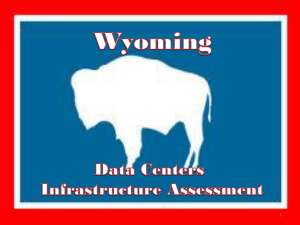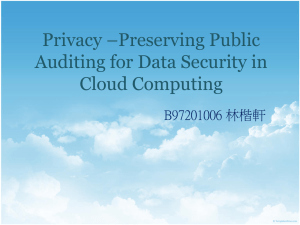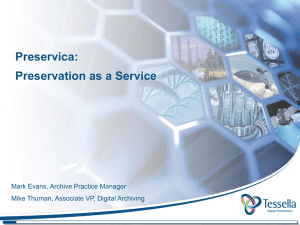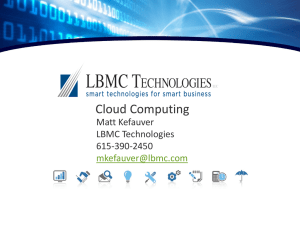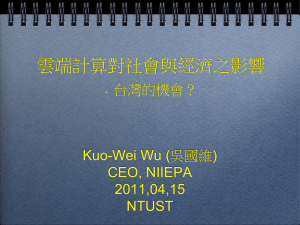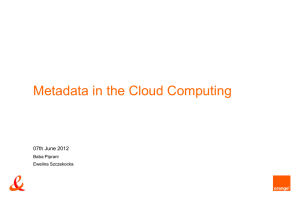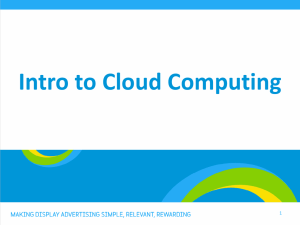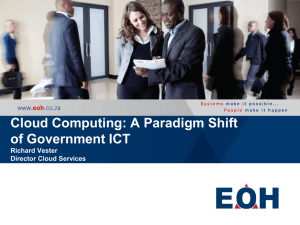7 Things You Should Know about Cloud Computing
advertisement
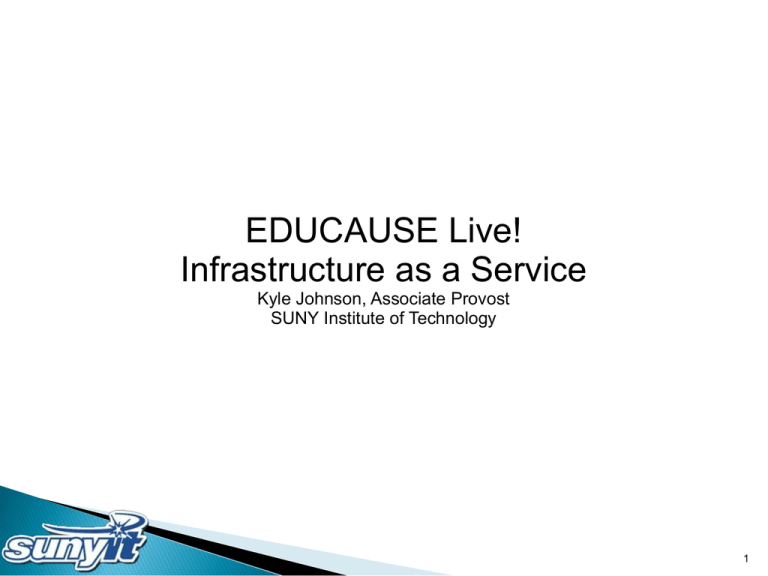
EDUCAUSE Live! Infrastructure as a Service Kyle Johnson, Associate Provost SUNY Institute of Technology 1 • Outline • • • • • • Quick background of me and my institution Overview of cloud computing generally Conceptual framework for infrastructure as a service Considerations when looking at IaaS Examples of IaaS Outcomes • Understanding of IaaS concepts • Ability to apply considerations to your institution • Willingness to consider IaaS for future needs 2 BA in Anthropology and M.Ed. in Higher Education Administration Been in this position for about six months Oversee all the traditional IT areas plus instructional design, online learning, the library, and our tutoring center Previously CTO at a Guilford College in Greensboro, NC Before that Director of Student Affairs IT at Duke University 3 Part of the State University of New York system and located in Utica, NY 2800 students by headcount (2050 FTE) Started in 1968 as an upper division comprehensive institution First campus buildings constructed in 1986 Became a technology focused college in early 1990’s In early 2000’s began accepting 1st year and sophomore students 4 “…the term cloud computing refers to the delivery of scalable IT resources over the Internet, as opposed to hosting and operating those resources locally, such as on a college or university network. Those resources can include applications and services, as well as the infrastructure on which they operate.” EDUCAUSE, 7 Things You Should Know about Cloud Computing <http://www.educause.edu/ir/library/pdf/EST0902.pdf> 5 “Infrastructure as a Service is a provision model in which an organization outsources the equipment used to support operations, including storage, hardware, servers and networking components. The service provider owns the equipment and is responsible for housing, running and maintaining it.” <http://searchcloudcomputing.techtarget.com/sDefinition/0,,sid201_gci1358983,00.html> 6 Traditional outsourcing of support Sourcing of major design and ongoing operations Purchasing service level 7 Prerequisites Financial Well designed and implemented identity management plan Robust, redundant network The cloud model tends to shift expenses from capital to operational Legal Important to understand where infrastructure will reside Contracts have to be constructed to ensure institution meets federal, state, and local obligations 8 Staffing New focus on contract and vendor relationships More interaction with institutional community in needs gathering and analysis Focus on integration of services Culture Shift away from the “not invented here” mentality IT operation loses some control to gain ability to meet community needs 9 Challenges of research computing Potential benefits of cloud based Can provision service as needed and pay for what you use Allows flexibility for different researchers Doesn’t require onsite expertise to maintain Amazon Elastic Compute Cloud (EC2) Uneven demand for services Expensive to setup and maintain Hard to justify for smaller teaching institutions Example 10 Challenges of server management Myriad of operating system choices requires lots of specialized in house expertise Space, HVAC, and power needs can be substantial, even for a small school Providing failover at remote location can be expensive Potential benefits of cloud based Can select OS based on need rather than availability of in-house knowledge Most providers include disparate remote locations No need for massive new data center infrastructure 11 Phasing in Might start with remote support contract for OS Move into heavier virtualization and have a partner design, build and manage the infrastructure Migrate VM infrastructure to offsite location Examples Amazon EC2 (with Virtual Private Cloud) Rackspace and GoGrid Regional higher education hosted private clouds 12 Challenges of storage management Always increasing customer demand for storage Hard to differentiate between enterprise and individual storage needs Storage Area Network (SAN) infrastructure can require significant capital outlay with short refresh cycles Potential benefits of cloud based Can more easily add capacity Provide custom solutions for enterprise and individual needs 13 Phasing in Might start with remote support contract for SAN Mirror SAN infrastructure to offsite location As server infrastructure moves to cloud, so does enterprise storage; provide cloud based solutions for individual storage Examples Nirvanix Storage Delivery Network (SDN) DropBox and Box.net Amazon Simple Storage Service (S3) 14 Challenges of backup management Potential benefits of cloud based Volume of data storage makes tape or disk management complicated Compliance with eDiscovery and retention laws Not all institutional data on central servers Data and compliance management simplified Can offer desktop/laptop backup options Examples Iron Mountain (enterprise) Mozy and Carbonite (desktop/laptop) 15 Challenges of desktop management Potential benefits of virtual cloud based OS and application patching Availability of applications to remote customers Ever decreasing refresh cycle for desktops Able to provide desktop environment anywhere Easier to manage virtual images Examples Panologic and NComputing (thin clients) ICC Global and Secure-24 (virtual desktop service) North Carolina State Virtual Computer Lab 16 Challenges of telephony management Potential benefits of cloud based Dial tone seen as necessary evil but not investment area Many institutions running on unsupported analog PBX systems No complicated PBX or VoIP systems to manage Only thing to manage on premise is handsets Examples PAETEC Hosted IP Telephony solution Apogeenet for residential telephony 17 Challenges of network management At some point, networks don’t “scale down” to smaller schools Increase of services on network demand more and more specialized expertise Potential benefits of cloud based Gain access to broader network expertise Ability to monitor and manage network 7x24 Better scaling both down and up Stabilization of cost (albeit operating instead of capital) 18 Phasing In Contract resources for specific network activities Partner with firm to design, build, and manage network (but still own hardware) Purchase network service level from provider and don’t own network hardware at all Examples Apoge.net for residential networks nfrastructure (new partner for SUNYIT) 19 Make the data center you have the last one you will ever need Everything doesn't need to be sourced at once, but start somewhere When opportunities arise TAKE THEM 20 Amazon Elastic Compute Cloud (EC2): http://aws.amazon.com/ec2/ Amazon Virtual Private Cloud (VPC): http://aws.amazon.com/vpc/ Rackspace: http://www.rackspacecloud.com/ GoGrid: http://www.gogrid.com/ Nirvanix Storage Delivery Network (SDN): http://www.nirvanix.com/solutions/tier-n.aspx DropBox: http://www.dropbox.com/ Box.net: http://box.net/ Amazon Simple Storage Service (S3): http://aws.amazon.com/s3/ Iron Mountain: http://www.ironmountain.com/online-backup/cloud-based-data-protection.html Mozy: http://www.mozy.com Carbonite: http://www.carbonite.com Panologic: http://www.panologic.com NComputing: http://www.ncomputing.com ICC Global Hosting: http://www.iccglobalhosting.com/ Secure-24: http://www.secure-24.com/virtual-desktop-infrastructure.html PAETEC Hosted IP Telephony Solution: http://paetec.com/products-services/voice/hosted-ip-telephony/overview.html Apogeenet (digital phone service for students): http://www.apogeenet.net/our-services/digital-phone/ Apogeenet (managed residential network services): http://www.apogeenet.net/our-services/student-networks/ Nfrastructure: http://www.nfrastructure.com/solutions/network/ 21


